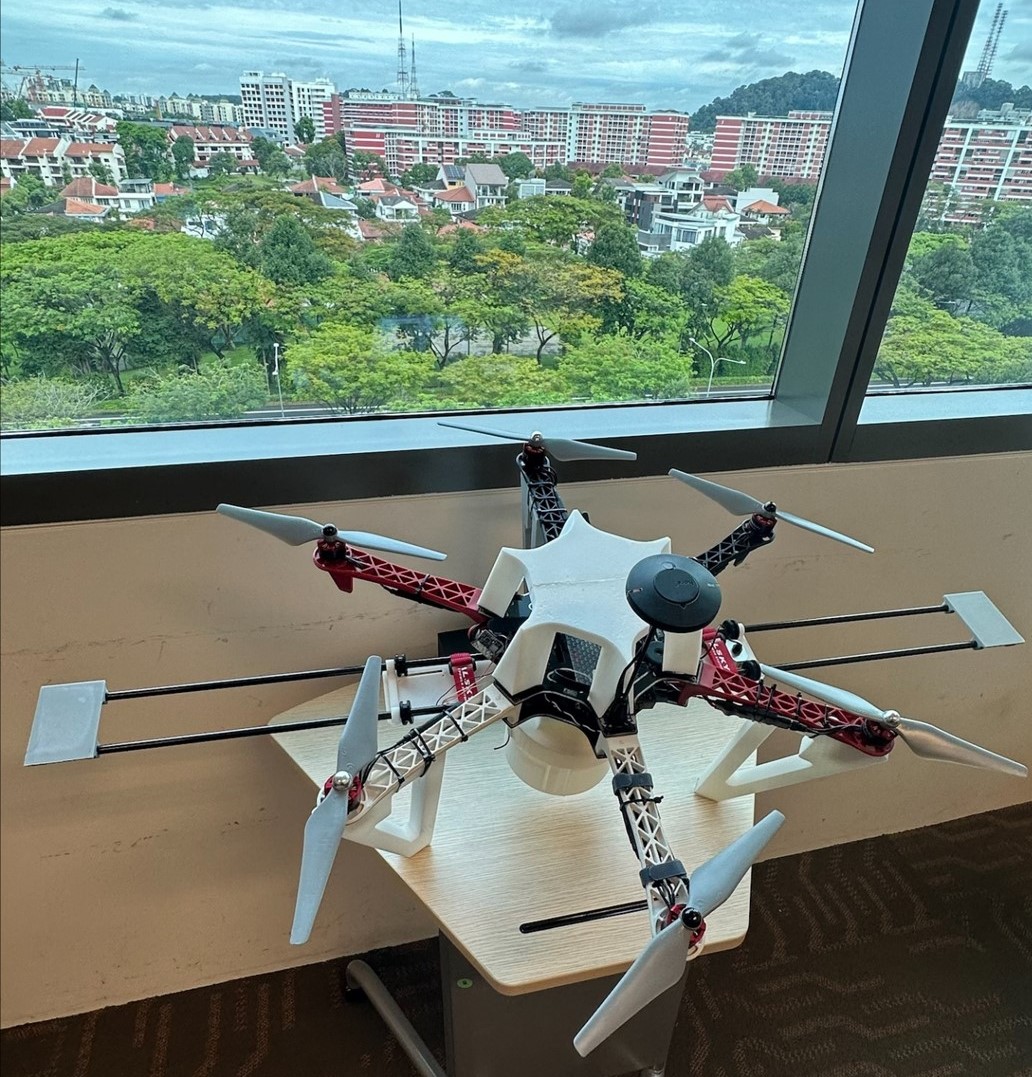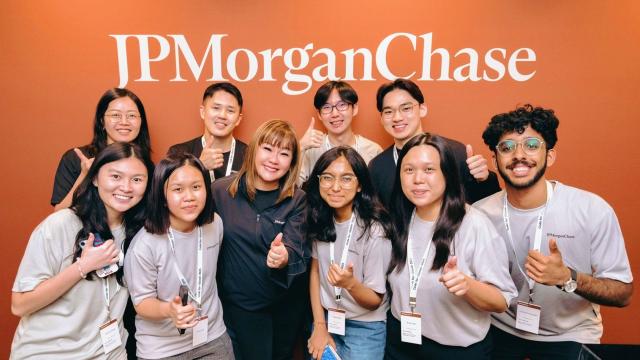Armed with a background in aerospace engineering and a passion for creating impact, this team of six Aerospace Engineering students built an autonomous drone that can skip the traffic and navigate Singapore’s skyline to deliver food – from scratch.

The team behind Fawkes (from left): Khosyi Di’bal bin Harjuna, Tan Wei He, Chu Meng Kang, Phoebe Victoria Chee, Chai Ming Keat, and Muhammad Khairel bin Ismail. (Photo: Phoebe Victoria Chee)
Chinese New Year festivities were in full swing, but the occasion was not the only cause for celebration for a certain group of six. In their hands lay a single, quintessential mandarin orange – unassuming, but not at all unimportant.
As they loaded the fruit into a food box attached to the drone they had painstakingly developed, they knew it was make or break. Slowly, it took off. One second became two, and before they knew it, the drone was hovering smoothly in the air. Their test run was successful.
Perhaps the fruit had brought about the luck it symbolised. But more than luck, this test run was a result of the team’s sustained efforts over the previous seven months -- a never-ending cycle of building, dismantling, rebuilding and executing test flights with the prototype of their autonomous food delivery drone.
Prior to this, they had experienced about 20 failed test flights, including one that saw their drone flying straight into the ceiling and crashing due to an unexpected voltage drop.
Their efforts paid off: they emerged runner-up at the Global Navigation Satellite System (GNSS) Innovation Challenge 2022, jointly organised by the Singapore Land Authority and the Space Faculty.
The team comprised six Year 2 students from the Aerospace Engineering degree programme, jointly offered by the Singapore Institute of Technology and University of Glasgow: Chai Ming Keat, Chu Meng Kang, Khosyi Di'bal Bin Harjuna, Muhammad Khairel Bin Ismail, Phoebe Victoria Chee, and Tan Wei He.
Food by Flight

Fawkes, the drone. (Photo: Chai Ming Keat)
The inception of their drone started in April last year, when the team received an email from their professor about the GNSS Innovation Challenge, which required participants to develop a last-mile autonomous robot capable of navigating robot-unfriendly spaces. Intrigued and emboldened by their background in aerospace engineering, they decided to take it up.
The result? An autonomous food delivery drone that could deliver food more quickly and safely than human riders. It was a timely invention. Following the pandemic, they realised that the demand for food delivery was at an all-time high. According to Grab’s Southeast Asia Food and Grocery Trends 2022 report, seven in 10 consumers view delivery as a permanent part of their post-pandemic life, and monthly food and grocery delivery expenditures were 30 per cent higher in May 2022 compared to November 2021. Singapore consumers spent most on deliveries.[1]
This increased pressure on both delivery platforms and riders, who inadvertently risked their lives daily. In fact, one in three riders got into accidents on the road.[2]
Thus, Fawkes was born. A nod to Dumbledore’s pet phoenix in the Harry Potter series, the drone resembles its fictional predecessor in many ways, according to Phoebe. For example, it can rise from the ashes, no matter how many times it experiences a crash-landing.
But more importantly, it is designed to be autonomous and intelligent enough to safely navigate any high-density city with high-rise buildings.
And at a speed of 10 m/s, Fawkes can travel a distance of three kilometres in just five minutes, delivering much more than the average of three to four orders that can be handled by a human driver, and keeping food warm for longer. In the context of the pandemic, using a drone also minimises the need for human-to-human interaction.
As it turned out, building a drone from scratch required more than just a background in aerospace engineering. This meant that the team picked up skills along the way. From getting their hands dirty with soldering, to sourcing for scrap drone parts and electrical components, to 3D modelling and programming, they paid attention to every detail.
“The first time that we learned how to design a drone was in one of our modules and even so, it was only in theory and concept,” said Khairel. “Creating a drone from scratch and seeing it fly was an achievement in itself.”
The Sky’s the Limit
Engineering is all about trial and error, and the team will not be stopping there. They are planning to scale up their prototype and further improve its capabilities.
Fawkes is suitable for cross-island food delivery, such as to nearby islands which may be difficult to access due to a lack of roads. The team hopes to increase the flight time so that Fawkes can fly longer distances. They also plan to make the food box detachable from the drone to ensure that contact is further minimised between the drone and customers.
Will their plans take off? The team is optimistic. They hope that Fawkes can one day be commercialised and certified by the authorities for use, Wei He shared.
“Drones will be used in the future to deliver food. We already see Google and Amazon using them for parcel delivery,” Khairel added. “If we have the chance to be one of the pioneers in the field, we would want to do so.”
[1] https://asiafoodjournal.com/grab-unveils-2022-delivery-trends-new-features/
[2] https://www.straitstimes.com/singapore/1-in-3-food-delivery-workers-needed-medical-aid-after-an-accident-ips-poll















![[FA] SIT One SITizen Alumni Initiative_Web banner_1244px x 688px.jpg](/sites/default/files/2024-12/%5BFA%5D%20%20SIT%20One%20SITizen%20Alumni%20Initiative_Web%20banner_1244px%20x%20688px.jpg)


